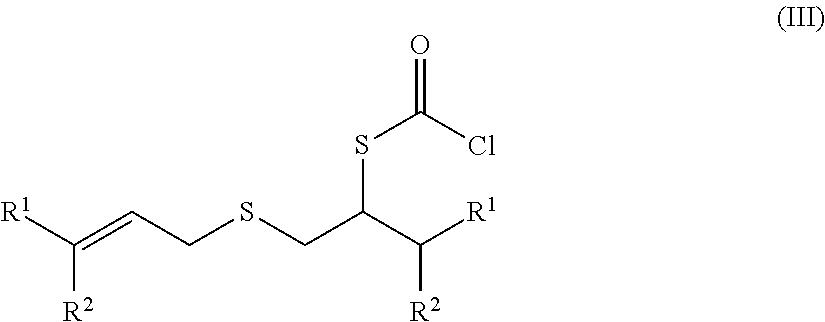Chlorothioformate manufacturing method
a technology of chlorothioformate and manufacturing method, which is applied in the preparation of carboxylic compound, carboxylic acid halide, organic chemistry, etc., can solve the problems that the above-mentioned processes are not necessarily satisfactory in the quality and yield of chlorothioformate, and achieve high quality chlorothioformate, sufficient suppression of the formation of by-product (ii) and good yield
- Summary
- Abstract
- Description
- Claims
- Application Information
AI Technical Summary
Benefits of technology
Problems solved by technology
Method used
Image
Examples
reference example 1
Preparation of Allyl Mercaptan (a Compound of the Formula (I) in which R1 and R2 are Hydrogen Atoms)
[0032]230.30 g (2.868 moles) of sodium hydrosulfide hydrate (a content of sodium hydrosulfide =70% by weight, a content of sodium sulfide =4.20% by weight, a content of sodium hydrosulfide in sodium sulfide =6.0% by weight), 200.11 g of water, 160.02 g of xylene, 111.24 g (0.333 mole) of a 69.6% by weight aqueous solution of benzyltriethylammonium chloride were charged to a glass reactor equipped with a reflux condenser, a thermometer, a stirrer and a jacketed dropping funnel, and stirred. Nitrogen was introduced into the gaseous phase in the reactor to maintain a nitrogen atmosphere.
[0033]Subsequently, 200.01 g (2.561 moles) of allyl chloride was charged to the jacketed dropping funnel and cooled to −2 to 5° C. Allyl chloride cooled was dropwise added over 7 hours while maintaining a reaction solution at 40° C. and the reaction solution was further maintained at 40° C. for 3 hours. T...
example 1
[0034]65.34 g (0.402 mole) of allyl mercaptan obtained by the process described in Reference Example 1, 2.37 g (0.032 mole, 40% by weight based on the whole amount of N,Ndimethylformamide) of N,N-dimethylformamide and 403.21 g of xylene were charged to a glass reactor equipped with a phosgene gas inlet, a reflux condenser, a thermometer, a stirrer and a jacketed dropping funnel and stirred. Subsequently, nitrogen was introduced into the gaseous phase in the reactor to maintain a nitrogen atmosphere. Then, 41.80 g (0.423 mole) of phosgene was introduced into the reaction solution over 2 hours while maintaining the reaction solution at a temperature of 39 to 41° C. Thereafter, a mixture of 195.31 g of allyl mercaptan (1.207 mole), 3.53 g (0.048 mole, 60% by weight based on the whole amount of N,N-dimethylformamide) of N,N-dimethylformamide was charged to the jacketed dropping funnel, cooled to 0 to 5° C. and dropwise added to the reaction solution over 5 hours while maintaining a temp...
PUM
| Property | Measurement | Unit |
|---|---|---|
| temperature | aaaaa | aaaaa |
| temperature | aaaaa | aaaaa |
| temperature | aaaaa | aaaaa |
Abstract
Description
Claims
Application Information
 Login to View More
Login to View More - R&D
- Intellectual Property
- Life Sciences
- Materials
- Tech Scout
- Unparalleled Data Quality
- Higher Quality Content
- 60% Fewer Hallucinations
Browse by: Latest US Patents, China's latest patents, Technical Efficacy Thesaurus, Application Domain, Technology Topic, Popular Technical Reports.
© 2025 PatSnap. All rights reserved.Legal|Privacy policy|Modern Slavery Act Transparency Statement|Sitemap|About US| Contact US: help@patsnap.com



